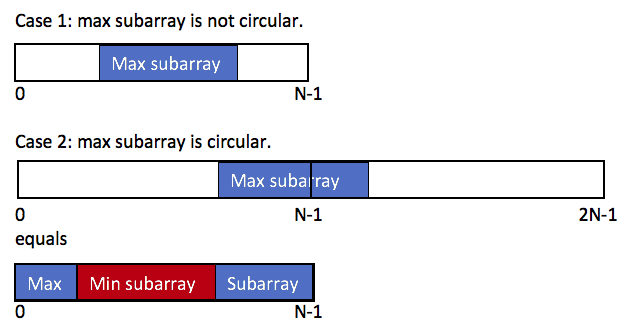Leetcode Week5 Maximum Sum Circular Subarray
阿新 • • 發佈:2019-01-02
Question
Given a circular array C of integers represented by A, find the maximum possible sum of a non-empty subarray of C.
Here, a circular array means the end of the array connects to the beginning of the array. (Formally, C[i] = A[i]
0 <= i < A.length, and C[i+A.length] = C[i] when i >= 0.)
Also, a subarray may only include each element of the fixed buffer A at most once. (Formally, for a subarray C[i], C[i+1], ..., C[j], there does not exist i <= k1, k2 <= j
k1 % A.length = k2 % A.length.)
Example 1:
Input: [1,-2,3,-2]
Output: 3
Explanation: Subarray [3] has maximum sum 3
Example 2:
Input: [5,-3,5]
Output: 10
Explanation: Subarray [5,5] has maximum sum 5 + 5 = 10
Example 3:
Input: [3,-1,2,-1]
Output: 4
Explanation: Subarray [2,-1,3] has maximum sum 2 + (-1) + 3 = 4
Example 4:
Input: [3,-2,2,-3]
Output: 3
Explanation: Subarray [3] and [3,-2,2] both have maximum sum 3
Example 5:
Input: [-2,-3,-1]
Output: -1
Explanation: Subarray [-1] has maximum sum -1
Note:
-30000 <= A[i] <= 300001 <= A.length <= 30000
Answer

有兩種情況。
第一,子陣列只有中間部分,我們知道如何找到最大子陣列求和。
第二,是子陣列頭陣的一部分,尾巴陣列的一部分。
最大的結果等於總和減去最小值子陣列只子陣列求和。
int maxSubarraySumCircular(vector<int>& A) { int total = 0, maxSum = -30000, curMax = 0, minSum = 30000, curMin = 0; for (int a : A) { curMax = max(curMax + a, a); maxSum = max(maxSum, curMax); curMin = min(curMin + a, a); minSum = min(minSum, curMin); total += a; } return maxSum > 0 ? max(maxSum, total - minSum) : maxSum; }
